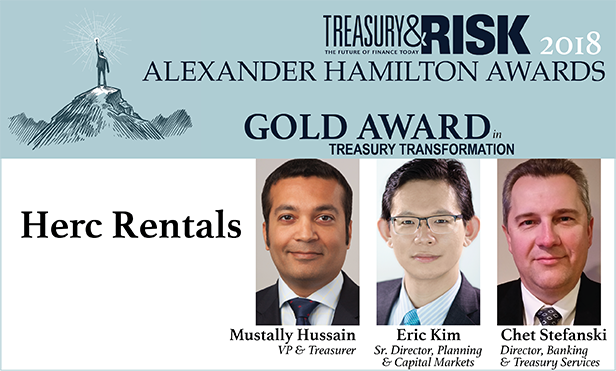
Divestitures are never easy. Standing up a separate company without disrupting ongoing operations, in either the new entity or the parent, is a major challenge in any circumstance. It's even more complex to accomplish when the newly formed company will have more than $1 billion in revenue and nearly 5,000 employees. That was exactly the challenge the management team undertook when Herc Rentals spun off from The Hertz Corporation in 2016.
With 270 locations across the United States and Canada, Herc Rentals is one of the leading equipment-rental businesses in North America. Its divestiture from the Hertz car rental company was announced in 2014. A new senior management build began in 2015, with planning for the new treasury team starting in March 2016, for a separation that July.
“None of the treasury staff or management team transitioned from Hertz to Herc,” explains Mustally Hussain, vice president and treasurer of Herc Rentals. “I started in May 2016, and Herc Holdings went public on the New York Stock Exchange on July 1, 2016. We had a TSA [transition services agreement] with our former parent for six months, so we had until the end of the year to build a treasury function from the ground up.”
Once Hussain was on board, he began to hire key treasury staff including Eric Kim, senior director of planning and capital markets, and Chet Stefanski, director of banking and treasury services. Their fledgling department needed to build out processes and operating models for every facet of treasury, as well as a new analytics infrastructure. Strategically, they needed to develop an understanding of the business's capital and liquidity needs and develop a financial strategy to meet those needs. All within six months.
“We had some knowledge of how treasury operations worked at the former parent,” Hussain says, “but they were managing treasury for the combined business, and much of what they were doing didn't apply to the new business. One key example is that some of Hertz's treasury operations were decentralized, but we decided it made sense for Herc to centralize all of treasury. We faced some different challenges, which meant aligning the solutions to meet the business needs. It also meant we were drinking from a firehose for the first six months.”
Hussain defined three pillars of treasury that needed to be built out: banking and treasury operations, corporate finance and strategic planning, and capital markets and exposure risk management. In the treasury operations arena, Stefanski started by re-evaluating the company's existing banking relationships and designing a banking platform to handle the demands of the cash-driven business.
“As part of the former parent, we utilized nine depository banks,” he says. “We gave business to banks near each of our key locations, so our cash was scattered all over the place. We decided to consolidate all our cash with two banks.” Disentangling those banking relationships was a challenge. “The plumbing on Hertz's bank accounts was completely intertwined with Herc's own plumbing for banking portals,” Hussain says. “Getting those separated for the separate businesses took some time.”
Herc Rentals' treasury team planned a technology infrastructure that would reduce the amount of time store employees throughout North America spent managing their cash and bank accounts. They carefully considered which employees needed access to each banking service, limiting access to those with a demonstrable business need. This process reduced bank fees by several hundred thousand dollars a year.
Then Stefanski invited the new company's partner banks to come into the Herc Rentals back office and make suggestions on how to streamline treasury processes. “We wanted to create an environment where store employees could use apps to deposit and manage cash, rather than having to drive to bank branches,” Stefanski says. “We also wanted to eliminate manual activities for staff. This streamlining enabled employees to be reassigned to other profitable activities.”
 At the same time, Herc Rentals developed a strong cash forecasting culture. Stefanski had used a 13-week forecast in previous jobs and introduced the same concept in the newly formed treasury function. “We brought in A/P [accounts payable], A/R [accounts receivable], and various other departments,” he says. “We educated them on where they fit in our cash-setting process and how essential it was for us to have accurate information in cash forecasts so we could reduce the amount of cash we carry on hand. In the last two years, since we started working on this, we've reduced our cash carry by more than 50 percent.”
At the same time, Herc Rentals developed a strong cash forecasting culture. Stefanski had used a 13-week forecast in previous jobs and introduced the same concept in the newly formed treasury function. “We brought in A/P [accounts payable], A/R [accounts receivable], and various other departments,” he says. “We educated them on where they fit in our cash-setting process and how essential it was for us to have accurate information in cash forecasts so we could reduce the amount of cash we carry on hand. In the last two years, since we started working on this, we've reduced our cash carry by more than 50 percent.”
The spinoff's management team also developed a financial strategy to de-risk its portfolio through capital markets transactions and strategic investment allocation. “We were starting from scratch in this area as well, and we saw a lot of room for redesign suitable to Herc's needs,” Kim reports. “We looked at our capital structure, our investment management, and our interest rate risk with a Herc-specific eye.” One key change was taking advantage of the redemption feature in Herc Rentals' more than $1.2 billion of corporate bonds. “We looked at how we could reduce the cost of debt over time,” Hussain says. “We were able to redeem some of our outstanding notes and replace them at a lower cost using our ABL [asset-based lending] facility. The reduction in the cost of debt—3 percent vs. 7.5 percent—has made our P&L stronger.”
The flip side of the funding management improvements were investment management changes. “By the time we were separated from our former parent, we had better visibility into the benefit plan assets,” Kim says. “We recalibrated our investment lineup to achieve significant returns.”
Finally, Herc Rentals centralized financial risk management, most notably management of the interest rate risks inherent in the corporate debt. Compliance with bond covenants is also a crucial financial risk management responsibility, and that too is centralized.
Hussain says the keys to success in building out Herc Rentals' treasury function were careful planning, flexibility, and hiring the right team. “Without that team, you just don't get there,” he says. “There's a tendency for people to reach a certain accomplishment and then become static. They look at what they've achieved, and they settle for continuing to do things that way. But if you want to become best-in-class, you have to continue evaluating yourself. Everyone on the team has to be committed to an iterative process for continuous monitoring and improvement.”
That commitment to continuous improvement enabled Herc Rentals treasury to end its TSA with Hertz a month early. “Because we were starting from ground zero, everyone in the treasury function needed to demonstrate an unwavering desire to get things done,” Kim says.
“Mustally has built a treasury culture where we're never satisfied with our current status,” Stefanski concludes. “We're always looking at how we can make processes better. We've come a very long way in the past two years, but there are still things we can improve. And we have the will to keep moving forward. We'd probably get bored if we didn't have a new challenge.”
© Touchpoint Markets, All Rights Reserved. Request academic re-use from www.copyright.com. All other uses, submit a request to [email protected]. For more inforrmation visit Asset & Logo Licensing.


